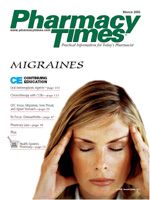Publication
Article
Pharmacy Times
Osteoarthritis Treatment Update
Author(s):
Osteoarthritis (OA) is the most common form of arthritis in the United States, affecting close to 50% of persons >65 years of age, and it is the second leading cause of chronic disability. Whether patients are self-treating or following health care provider advice, pharmacists are in a unique and ideal position to assist those who have this common disorder.
What Is Osteoarthritis and Who Gets It?
The term arthritis often is used as a euphemism for OA, but this term encompasses other disorders, including rheumatoid arthritis and juvenile chronic arthritis. Unlike other arthritic disorders, however, the typical underlying cause of OA is not inflammation, but degeneration.1 This degeneration causes a progressive loss of cartilage in addition to surrounding bone growth. OA presents primarily in the weight-bearing joints of the knees and the hips, but it also may occur in the spine and in the hands (Figures 1 and 2).
Factors that give patients a greater risk of developing OA include advancing age, repetitive trauma, and heredity. Symptoms include pain, reduction in joint mobility, morning stiffness, gelling after inactivity, crepitus on motion, and joint deformities. Limitations on activities of daily living and decreased quality of life develop, as well as increased cost to the patient and the health care system.
What Should Be Accomplished by Treating OA?
The end results of pain and reduction in activities of daily living (ADLs) are similar among the different types of arthritis. Therefore, the goals of treating patients also remain similar to those for other arthritic conditions and include (1) decreasing pain, (2) increasing ADLs, and (3) slowing the progression of the disease. The approach to treatment, however, varies because of the lack of inflammation in the pathogenesis of the disease and the influence of degeneration on joint integrity.
How Are Patients with OA Treated?
The American College of Rheumatology (http://www. rheumatology.org) in 2000 and the European League Against Rheumatism in 2003 published guidelines for the treatment of patients with OA at different locales (ie, hip and knee).1,2 These guidelines provide assistance for the appropriate treatment of this disorder but are limited by the length of time between publication and newer evidence that has been produced. Included here is a summary of important concepts in the treatment of OA, largely supported by these recommendations, and new evidence, which may change the approach to the OA patient.
Nonpharmacologic Treatment
In addition to exogenous drug therapy for the treatment of OA pain and associated symptoms, the most beneficial course of action for OA is to treat the underlying cause. Most patients with OA have developed the disease over a longtime course in the weight-bearing joints of their body, such as the knees, hips, and spine. Conditioning of the muscles around these joints with physical therapy and weight loss have proven to improve symptoms and ADLs.1 Walking sticks, insoles, and knee braces are additional therapies that may provide relief in hip and knee OA.2 If a patient's disease progresses beyond the point where modification with lifestyle and pharmacologic therapy are successful, joint-replacement therapy is an option.
Pharmacologic Treatment
Acetaminophen, Capsaicin, Glucosamine
Prescription medications often are used in the treatment of OA, but OTC medications are the typical first-line therapies due to their efficacy, favorable safety profiles, and (in the case of glucosamine) disease-retarding effects. Patients may begin with one or all of the following: acetaminophen, topical capsaicin, and the natural medicine glucosamine sulfate.
Treatment reaches its full benefit following continuous therapy for 4 to 6 weeks. Notifying patients of this delay in therapeutic response will help to ensure compliance with therapy and lower the likelihood of false therapeutic failures. If a patient does not respond or has only partial response to initial therapy, other complementary medications may be added or substituted. Dosage, regimen, place in therapy, and "clinical pearls"of common OTC and Rx products are listed in the Table.
If patients fail first-line OTC therapies, second-line OTC/Rx therapy is warranted. Factors that contribute to therapeutic failure include noncompliance with initial therapy, inadequate duration of therapy, and variable patient response. Proper assessment of the patient to determine the most likely cause of therapeutic failure is warranted before optional therapeutic regimens are recommended. Providing information to patients with educational deficits and tailoring the use of compliance tools with a nonjudgmental attitude are valuable methods to improve patient's usage and success with therapy. If therapy is not providing adequate benefit despite adherence to the chosen first-line therapies, the initiation of optional second-and third-line therapies is appropriate.
NSAIDs
Nonsteroidal anti-inflammatory drugs (NSAIDs) provide effective alternatives for patients who do not respond to acetaminophen analgesic therapy or who have a component of inflammation. For analgesic effect, doses on the lower end of therapeutic provide adequate effect and lower risk of side effects. Clinicians may choose from any of the available NSAIDs and may interchange therapy in patients who do not respond to one after an adequate trial of 4 to 6 weeks. Recently studies have implied an increased cardiovascular (CV) risk with the use of NSAIDs. Ibuprofen has been shown to counteract the antiplatelet effects of aspirin; naproxen, studied in the prevention of Alzheimer's disease, preliminarily suggests an increase in CV events; and, non- specifically, NSAID discontinuation may increase the risk of acute myocardial infarction within 30 days of discontinuation.3-5 As a result, the FDA is evaluating the evidence and, in the case of naproxen, recommending that patients have no longer than a 10-day course of treatment before discussing therapy with their health care provider. The evidence to date, however, is not complete and does not suggest automatic elimination of NSAIDs from the OA treatment algorithm.
COX-2 Inhibitors
Cyclooxygenase-2 (COX-2) inhibitors are effective analgesic and anti-inflammatory agents that are useful in the treatment of OA. In addition, they have a lower incidence of severe gastrointestinal (GI) side effects than the nonspecific NSAIDs. Since the release of this class of drugs, their popularity and use have escalated.
Despite similar efficacy to NSAIDs and reduced GI side effects, COX-2 inhibitor use has been associated lately with an increased risk of CV events. Both rofecoxib (Vioxx) and valdecoxib (Bextra) showed strong evidence of this increased risk in well-designed recently published trials.6-9 This evidence led ultimately to the voluntary withdrawal of rofecoxib from the market in September 2004, although a recent FDA panel recommended that all 3 COX-2 agents remain on the market.
Mechanistically, rofecoxib (and valdecoxib) produce a very selective blockage in the production of prostaglandin I2 (prostacyclin), which is antithrombotic through COX-2 inhibition. Nonselective NSAIDs also block COX-2, but they have additional action on COX-1, which inhibits the production of thromboxane A2, which is prothrombotic. The end result with selective COX-2 inhibitors is a potentially prothrombotic condition. Celecoxib (Celebrex) also is COX-2-selective, but less selective than rofecoxib and valdecoxib?which may explain its lower CV risk when used in low doses (maximum 200 mg daily).10,11
Additionally, alarming information has been reported to the FDA implicating valdecoxib in the development of serious skin disorders, including Stevens-Johnson syndrome and toxic epidermal necrolysis. Symptom presentation usually begins within 2 weeks of therapy initiation, but it may occur at any time. Interestingly, 23% of these cases noted a documented sulfonamide allergy in the patient. This information prompted the FDA to issue a "black box"warning stating that "patients taking Bextra have reported serious, potentially fatal skin reactions, including Stevens-Johnson syndrome and toxic epidermal necrolysis,"and advising physicians to discontinue the drug at the first sign of a skin eruption or an allergic reaction.12
As a result, what was once thought of as a lack of protective CV benefit with COX-2 inhibitors is now firmly believed to be an increase in CV event risk. Current selection of COX-2 inhibitors is now limited to celecoxib and valdecoxib. Patients with high GI ulceration and bleed risk who have failed on acetaminophen therapy may qualify for COX-2 therapy, but an NSAID with a GI protective agent (ie, misoprostol or a proton pump inhibitor) is an equally effective and GI-tolerant option. Patients should be cautioned about the potential for increased CV risk, and treatment with other modalities should be given preference.13
Other Analgesics
Nonopioid and opioid analgesics provide alternatives for patients who cannot tolerate or continue to have pain despite other first-and second-line therapies. Symptomatic relief is possible with these agents, but side effects and fear of long-term use and abuse limit their use. Patients should be counseled regarding side effects and expectations of treatment with these agents.
Conclusion
The pharmacist is ideally situated to assist patients with OA. As a result of the high OTC medication use combined with prescripti harmacists are the central health care provider for patients receiving treatment. Pharmacists' opportunities for involvement include the assessment and management of patient drug selection, use, compliance, and maintenance. Pharmacists should be aware of the current guidelines for the treatment of OA, as well as continuous new information, particularly regarding the CV effects of the commonly used NSAIDs and COX-2 inhibitors.
Dr. Wright is an associate professor at Wilkes University and a clinical pharmacy specialist with the Wilkes-Barre VAMC.
For a list of references, send a stamped, self-addressed envelope to: References Department, Attn. A. Stahl, Pharmacy Times, 241 Forsgate Drive, Jamesburg, NJ 08831; or send an e-mail request to: [email protected].







